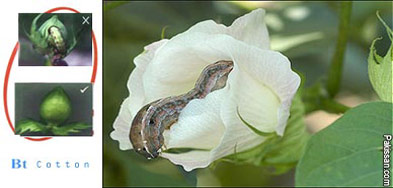|
|
Future of Bt Cotton
 Muhammad
Faisal Bilal and Dr. Muhammad Farrukh Saleem Muhammad
Faisal Bilal and Dr. Muhammad Farrukh Saleem
Department of Agronomy, University of Agriculture,
Faisalabad.
Every new technology has its benefits and risks; the
benefits associated with the use of transgenic crops
include: a dramatic decrease in the use of conventional and
broad-spectrum insecticides, target pest specificity,
improved yield, lower production costs and compatibility
with other biological control agents while some risks are
also associated with transgenic crops include out-crossing
by the transfer of pollen to non-transgenic plants, food
safety concerns, development of resistance in target pests
and effects on non-target organisms and biodiversity. Global
adoption of Bt cotton has risen dramatically from 0.76
million hectares in its introductory period in 1996 to 37.67
million hectares in 2010. Bollworms are serious pests of
cotton causing 30-40% yield reduction in Pakistan, and 20-66
% potential crop losses in India. The major advances shown
in this review are.
The growing of transgenically modified cotton that expresses
insecticidal protein derived from Bacillus thuringiensis
(Bt) is revolutionizing cotton production on a global scale.
The first Bt transgenic cotton variety (called Bt cotton),
expressing the same gene construct of Cry IAc, was
commercially released in Austriala (INGARD) and the United
Stated (BOLLGARD) in 1996. Agriculture plays a pivotal role
in the economy of Pakistan. It contributes about 24% to
national GDP and employs 44% of the total labor force;
Cotton (Gossypium hirsutum L.) is the main cash crop and is
known as “White Gold”. Pakistan is the fourth largest
producer of cotton after China, USA and India. During year
2010, Pakistan Agricultural Research Council (PARC) imported
almost 950 kg seed of five different types of Bt cotton from
China under special permission for conducting trails
directly on farmers' fields without following the rules and
regulations designed by NBC, PCCC, FSC & RD.
Transgenic cotton cultivars showed possible role to control
three main pests i.e., Helicoverpa armigera, Diparopsis
castanea and Earias biplaga. Farmers are using US$ 300
million worth of pesticides annually, out of which more than
75% is used on cotton crops to control pests, especially
bollworms. However due to introduction of Bt cotton, the
number of spray operations per crop (cotton) has been
reduced. Field studies in China have shown that by adopting
Bt cotton, farmers have reduced pesticide and labour costs,
and there is less exposure to toxic insecticides.
Bt transgenic cotton line increased leaf amino acid content,
but more nutrients were utilized for stem and branch growth.
High nitrogen and high vegetative growth produced significantly
less lint in Bt cotton cultivar. An increase of leaf NR
activity and NO3-N enhanced boll shedding for Bt cotton
cultivars. Total nitrogen reduced sharply in the bolls of
the Bt cotton cultivars; the reduction of total nitrogen
caused a decrease in nitrogen metabolism and limited boll
development; there was significantly positive correlation
between GA3 (Gibbleric Acid) content at flowering and boll
size in Bt cotton cultivars. This result also suggests that
reduction of GA3 may induce the decline of nitrogen
absorption and metabolism, thus affecting boll development.
In Pakistan cotton growers use a desirable amount of N (125
kg ha-1) but use of K is negligible (0.7 kg ha-1). The less
use of K fertilizer in Bt cotton may have serious
consequences including depressed growth and development in
the form of reduced plant height, leaf area index, leaf and
stem weights, decreased photosynthesis and stomatal
conductance, increased mesophyll resistance, low chlorophyl
content, poor chloroplast ultrastructure and ultimately the
total plant however, the termination of reproductive growth
and natural cutout occurs earlier than those who received
full potassium fertilizatoin. Excessively hot weather also
compounds K-deficit problems in cotton.
Factors affecting toxicity of Bt cotton Cry1Ac protein
content in Bt cotton was significantly reduced by high
temperature, NaCl stress, and nitrogen deficiency, whereas
high dose of N fertilizer, or foliar applications of the
plant growth regulator Chaperone, greatly improved the
Cry1Ac protein levels, resulting in increased mortality of
bollworms feeding on the treated plants. The field
observations of Australian Bt cotton showed that plants
expressing the Cry1Ac protein are less toxic to first-instar
H. armigera when the leaves are from fruiting versus
presquare plants. Terpenoids fluctuate temporally and levels
of condensed tannins generally increase with plant age, so
both may play some part in changing the efficacy of Cry1Ac
protein. Tannins can alter the efficacy of Bt toxins against
target species. Many researchers reported increased
mortality in lepidopteran species when hydrolysable tannin
compounds were combined with various Bt toxins in bioassays.
Removal of fruiting forms leads to great morphological and
physiological changes, including lint yield variation
ranging from small increase to large decrease. Nitrogen
metabolism affected Cry1Ac protein content, and removal of
early fruiting forms could change the nitrogen metabolism,
we also hypothesized that removal of early fruiting branches
may increase the Cry1Ac protein content in Bt cotton plants.
Due to industrial revolution level of atmospheric CO2
concentration has risen from 280-360 ppm which is
anticipated to double by the end of this century. This
increase may have a variety of direct and indirect effects
on relationships between host plant, their herbivores and
the herbivores natural enemies. Elevated CO2 tends to
increase photosynthetic rates, growth, yield and C:N ratio
in most C3 plants. Only limited research has been reported
on the effect of elevated CO2 on transgenic Bt cotton or the
effects on bollworms fed Bt cotton grown in elevated CO2. An
elevation of CO2 level from 330-660 ppm led to 95 % yield
increase in cotton. Increases in solube sugar, starch, total
non-structural carbohydrates (TNC), TNC:Nitrogen ratio,
condensed tannin, gossypol and decreases in water content,
nitrogen and Bt toxin protein were observed in the young
bolls from cotton plants grown under elevated CO2 conditions
compared with those in ambient CO2–grown cotton for both Bt
and non-Bt cotton.
|
|
Pakissan.com;
|